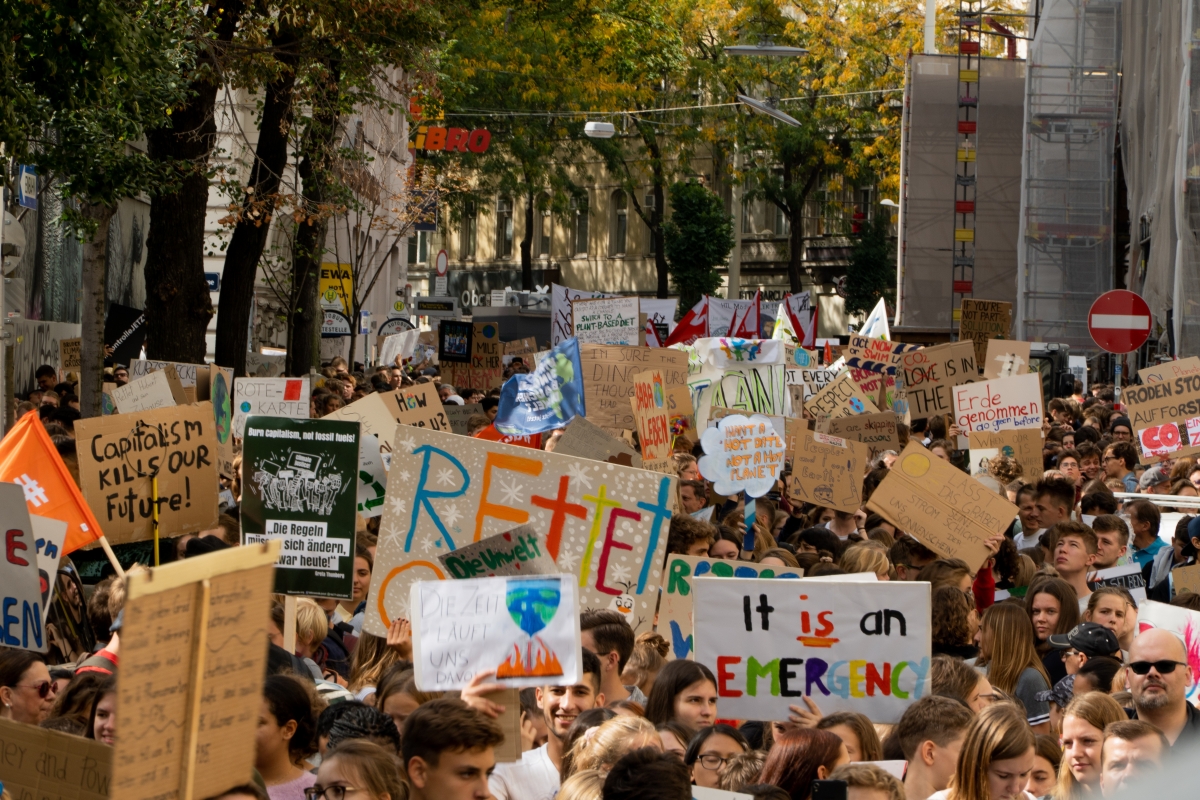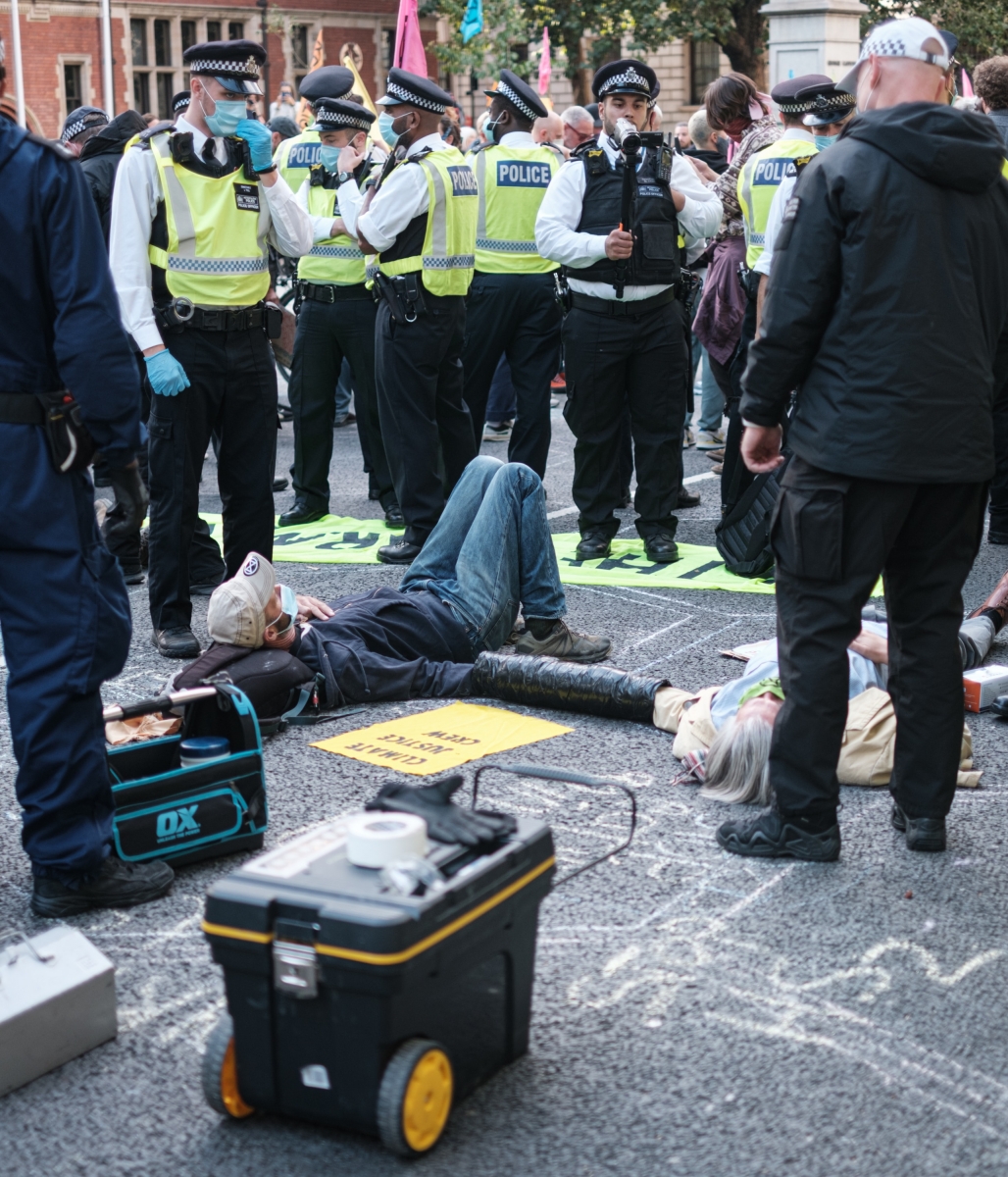From moderate to radical - will failure change the climate movement? Psychological studies on the impact of success and failure on social movements
Editorial Assistants: Rina Meerson and Elena Benini.
Note: An earlier version of this article has been published in the German version of In-Mind.
While the report of the Intergovernmental Panel on Climate Change (IPCC) warns of an escalation of the climate crisis and climate movements call for effective measures to mitigate climate change, their political implementation is making slow progress. How will this perception of failure and frustration impact the climate movement? Does it lead to their fragmentation and radicalization, or do they persist with previous forms of action? This article describes psychological studies on the effects of perceived success and failure by social movements.Collective action as game changer in the climate crisis?
Environmental movements like Fridays for Future or the Last Generation are prominent examples of collective action that set the climate crisis on the public agenda and increased political pressure for action. Collective action is the “coordinated action by a group of people to achieve a common goal” [1]. Such collective action has changed the world, a real game changer: The climate crisis is no longer a solely private matter. People are using their collective and political engagement to ensure that political conditions enable individual lifestyle changes for many in a socially just way.
 Figure 1: Demonstration for more effective mitigation of climate change
Figure 1: Demonstration for more effective mitigation of climate change
And yet, in times of multiple global crises such as the wars in Ukraine and the Middle East, ambitious climate mitigation measures seem to be less urgent in socio-political discourse. In Germany, for example, the climate mitigation act had to be tightened following a ruling by the Federal Constitutional Court in 2021. In 2023, the German government however weakened the climate mitigation act again, softening sector targets and stopping annual reviews [2]. Success has been followed by failure, spreading frustration within the climate movement and prompting activists to discuss and implement more radical protests. In particular, the Last Generation has been drawing attention to the climate crisis through civil disobedience (e.g. blockades of traffic routes) because they believe that moderate forms of protest do not have sufficient influence on climate policy [3]. However, at the same time, Fridays for Future Germany publicly distanced themselves from the Last Generation and its tactics [4]. This example illustrates ambivalent perspectives about future strategies within the climate movement, which are similarly reflected in societal attitudes towards different forms of protest [5].
While pursuing the aim of changing societies, social movements can fail and succeed several times [6]. But which consequences will the experience of failure and frustration have on the future of the climate movement? Does it lead to a fragmentation or radicalization of the climate movement? Are successful tactics increasingly used? Or does failure reduce the willingness of activists to engage collectively in climate policy? Using studies on the effects of perceived success and failure on social movements, we describe which goals activists have, how their goals change over time and how the success and failure of movements influence collective action.
Goals of collective climate actions
For a long time, the debate and communication on the climate crisis focused on changes in individual consumer behavior and less on the societal changes necessary to mitigate climate change. However, the influence of individual private sphere actions (such as waste separation, environmentally friendly consumption habits, water and energy conservation) has little impact on environmental quality. Public sphere and collective actions (e.g., membership in environmental groups, initiating or signing petitions, participating in demonstrations) are potentially more effective in reducing environmentally harmful human impacts than actions by individuals. By increasing the influence of environmental movements, such collective efforts can drive systemic changes to solve a problem collectively [7, 8]. Such actions are effective because they change conditions that influence the actions of many individuals and economic actors, such as environmental laws, taxes and subsidies. Changing these conditions is crucial to avoid wasting the time that remains to save the livelihood of humans.
The goals and forms of protest of collective action are dynamic and can change quickly, depending on the target groups they address, the reactions they provoke, and the opportunities or barriers arise [9]. Goals can range from abstract and holistic ambitions, such as achieving climate neutrality by 2030, phasing out fossil fuels (or at least reducing subsidies for them), to specific demands like establishing cycle paths. These demands can trigger societal and media debates, while also raising awareness and mobilizing people.
Goals and protest forms within the climate movement have changed in recent years. While extreme weather events are becoming more intense and more frequent and the remaining window of opportunity for effective climate action is rapidly closing, groups like the Last Generation see a glaring contradiction between the worsening climate crisis and the rather restrained political measures to mitigate it. From the perspective of some climate activists, conventional forms of protest have failed to bring about necessary political action, prompting a shift toward “unconventional” or “more radical” forms of political participation [3]. Conventional collective actions include actions that conform with the norms of the social system in a broader sense, such as petitions, peaceful and authorized strikes or lobbying. In contrast, radical collective actions are non-normative actions and include acts of political participation, such as non-violent resistance in the context of civil disobedience that (symbolically) violates laws (e.g., blockades, protest camps) or even violent actions, as known from extremist contexts [9, 10].
 Figure 2: Unconventional protest for effective climate mitigation measures.
Figure 2: Unconventional protest for effective climate mitigation measures.
In public discourse, a supposed radicalization of certain groups within the climate movement is repeatedly discussed, primarily due to the actions of activist groups like the Last Generation. However, the term “radicalization” is often used in a context associated with extremist or terrorist groups, implying hostility towards the state and criminalizing parts of the climate movement [3]. Yet, even though it regularly acts in violation of the law, the Last Generation is not classified as extremist, neither by court, police authorities or nor academia. The central justification given by the Last Generation is its focus on the common good, particularly protecting the livelihoods of future generations. This raises the question of whether their methods of protest match their goals: if the survival of humanity is directly at risk, is glueing oneself to the streets radical or rather proportionate to the threat of a climate catastrophe [3]? Moreover, their members support democracy and the state, reject violence against people and demand that governments comply with the 1.5-degree limit which is democratically legitimized in the Paris Climate Agreement [11, 3]. But how could the climate movement, their protest forms its members’ attitudes change in the event of recurring failure?
How do experiences of failure affect social movements?
The Social Identity Model of Collective Action (SIMCA model; [12]) explains that people support social movements if they identify with the movement and its goals. They are also more likely to join a movement if they believe that its actions are effective and that they can make a difference. In general, the perception of a movement's collective effectiveness motivates people to participate in the movement. However, empirical studies on the willingness of young adults to participate in climate movement actions show that collective effectiveness beliefs are less influential than the perceived relevance of personal involvement for the success of the movement. This creates a paradox where people who are convinced of the collective effectiveness of a movement may be less willing to participate in movement actions if they see no additional benefit in their own participation [13]. The perceived success of social movements therefore plays a critical role attracting additional supporters.
The DIME model (dis-identification, innovation, moralization and energization) (see Figure 3) describes how supporters respond to the success or failure of their social movement [9]. If social movements achieve (partial) success, this strengthens group identification and encourages continued use protest methods because of the experience of collective efficacy. However, social movements rarely achieve their goals directly. Instead, they often experience repeated failures for years in pursuing their political goals. The long-term success of a social movement depends therefore on how its members deal with these failures. According to the model, reactions to failure can vary. Some members lose their identification with the movement and leave. Others see it as proof that different tactics are needed and therefore turn to more radical methods. Although radical groups are often very present in the media, they are usually a minority. In the case of enduring movements, most members stick to their chosen tactics, intensify their activities, or emphasize the moral obligation to continue [9].
![Figure 3: DIME Model (translated according to [9]).](/sites/default/files/figure_1_3.png) Figure 3: DIME Model (translated according to [9]).
Figure 3: DIME Model (translated according to [9]).
The DIME model aligns with findings from social-psychological studies. In these studies, people who support a movement were surveyed before and after a political decision related to their movement’s goals. Researchers investigated how perceived failure affects identification with the movement, the willingness to support more radical forms of protest, and attitudes towards democracy. Findings show that failure leads to different and sometimes even contradictory reactions [14]. For some, identification with the movement weakens after experiencing failure, while for others, willingness to get involved increases, along with support for more radical forms of protest. Reactions to failure also seem to depend on emotions. People who experience strong negative emotions (such as anger) are more likely to stay involved and support more radical tactics [15]. The shift towards accepting “radical” protest seems to happen over time: people who initially reject radical methods before the experience of failure stick to more moderate forms. Only the repeated experience of failure leads to a stronger acceptance of more extreme actions. Moreover, the way political decision-makers deal with protests also influences activists’ reactions to failure. If activists experience the political system as unjust, they are more likely to lose faith in democracy and support more radical actions [14]. These findings are consistent with political analyses of the development of the Last Generation. Many members describe feeling angry about inadequate climate policy and resorting to “more radical” protests because they believe previous efforts have failed to bring about necessary political climate protection measures [3].
Movements typically include specific collective actions as part of medium- or long-term strategies to change political, social and economic conditions [9]. This makes it sometimes difficult to clearly separate success and failure [6], [14]. On the one hand, a setback that is initially perceived as a failure can be a learning opportunity to change future tactics (e.g., collaboration with other groups), which may lead to future success. On the other hand, temporary success is just one step towards achieving the overarching goal and may not last. For example, the success of movements can provoke counter-movements, so that successes are diminished or even reversed [6]. This shows how difficult it is to clearly determine the effectiveness of a movement.
What can we learn from these findings for the future of the climate movement?
Fridays for Future, as the most prominent example of the climate movement, has been able to mobilize many people since 2019. They influenced public and political discourse through mobilization. For example, in Germany, a successful constitutional complaint led to a stricter climate protection act, which is ultimately perceived as a major success of the climate movement. Political changes are, however, slow and are sometimes reversed. This leads parts of the climate movement, such as the Last Generation, to believe that public attention - and pressure on political decision-makers - can only be achieved through more radical forms of protest [16]. In public perception, Fridays for Future is seen as the moderate part of the climate movement, while the Last Generation is perceived as a more radical flank [5]. Such “radical flanks” can increase support for moderate groups [17]. It is an open question whether the climate movement can benefit from such a radical flank effect. Empirical evidence for this trend is not yet conclusive.
Conclusion
Will failure change the climate movement? In contrast to the studies mentioned above, there will likely be no single moment when all demands of the climate movement are met or definitely rejected. Rather, it is more realistic to expect an ongoing process of negotiation and a continuous, small-scale implementation of climate policies. This is partly because many people still not fully understand the extent of the threat posed by climate change and the urgency of adequate countermeasures. As a result, the climate movement will likely continue to adapt its goals and forms of protest to changing conditions.
This adaptability seems crucial for achieving effective mitigation and adapation strategies. Without the pressure created by the climate movement, the desired changes may not happen - or at least not quickly enough. Therefore, collective actions, in addition to individual climate-friendly actions, are necessary to mitigate climate change. People need to be informed about various forms of collective action, which highlights the need for political climate education. Such education can empower people to contribute effectively to collective efforts.
Bibliography
[1] Landmann, H., & Rohmann, A. (2020). „Wir sind hier, wir sind laut, weil ihr uns die Zukunft klaut!“ – Warum engagieren sich Menschen gemeinsam für den Umweltschutz [We are here, we are loud, because you are stealing our future!" - Why are people working together to protect the environment?]? Das In-Mind Magazin, 2. https://de.in-mind.org/article/wir-sind-hier-wir-sind-laut-weil-ihr-uns-.
[2] Expertenrat für Klimafragen [Expert Council for Climate Issues] (04/17/2023). Expertenrat sieht Klimaziele 2022 nur teilweise erreicht und ordnet die geplante Novelle des Klimaschutzgesetzes ein [Expert Council sees climate targets for 2022 only partially achieved and ranks the planned amendment to the Climate Protection Act]. https://www.expertenrat-klima.de/news/expertenrat-sieht-klimaziele-2022-... (retrieved on 09/262023).
[3] Rucht, D. (2023). Die Letzte Generation: Eine kritische Zwischenbilanz [The last generation: a critical interim assessment]. Forschungsjournal Soziale Bewegungen, 36(2), 186-204.
[4] Zweites Deutsches Fernsehen / ZDF (12.04.2023). Fridays for Future: Kritik an Protesten der "Letzten Generation" [Fridays for Future: Criticism of protests by the “last generation”]. ZDFHeute. https://www.zdf.de/nachrichten/politik/klima-fridays-for-future-kritik-l... (retrieved on.09/262023)
[5] Betsch, C., Eitze, S., Sprengholz, P., Korn, L., Shamsrizi, P., Geiger, M., Sievert, E.; Lehrer, L., & Jenny, M. (2023). Ergebnisse aus dem Planetary Health ACtion SurvEy - PACE [Results from the Planetary Health Action Survey]. Wave 14, Date of survery: 05/14-15/2023. Status: 08/25/2023. https://projekte.uni-erfurt.de/pace/summary/14/
[6] Louis, W. R., Thomas, E. E. F., McGarty, C., Lizzio-Wilson, M., Amiot, C., & Moghaddam, F. (2020). The volatility of collective action: Theoretical analysis and empirical data. Advances in Political Psychology, 41(S1), 35–74. https://doi.org/10.1111/pops.12671
[7] Kranz, J., Schwichow, M., Breitenmoser, P., & Niebert, K. (2022). The (un)political perspective on climate change in education—a systematic review. Sustainability, 14(7), 4194. https://doi.org/10.3390/su14074194
[8] Wright, S. C., Taylor, D. M., & Moghaddam, F. M. (1990). Responding to membership in a disadvantaged group – from acceptance to collective protest. Journal of Personality and Social Psychology, 58(6), 994–1003. https://doi.org/10.1037/0022-3514.58.6.994
[9] Gulliver, R., Wibisono, S., Fielding, K., & Louis, W. (2021). The Psychology of Effective Activism (Elements in Applied Social Psychology). Cambridge: Cambridge University Press. https://doi.org/10.1017/9781108975476
[10] Tausch, N., Becker, J., Spears, R., Christ, O., Saab, R., Singh, P., & Siddiqui, R. N. (2011). Explaining radical group behaviour: Developing emotion and efficacy routes to normative and non-normative collective action. Journal of Personality and Social Psychology, 101, 129-148.
[11] Mullis, D. (2023). Ungehorsamer Klimaprotest. Proteste werden intensiver – eine Radikalisierung in die Gewalt ist nicht in Sicht [Disobedient climate protest. Protests are intensifying - radicalization into violence is not in sight]. PRIF-Spotlight, 1/2023. https://doi.org/10.48809/prifspot2301
[12] Van Zomeren, M., & Iyer, A. (2009). Introduction to the social and psychological dynamics of collective action. Journal of Social Issues, 65(4), 645-660. https://doi.org/10.1111/j.1540-4560.2009.01618.x
[13] Bamberg, S., Rees, J., & Seebauer, S. (2015). Collective climate action: Determinants of participation intention in community-based pro-environmental initiatives. Journal of Environmental Psychology, 43, 155-165. http://dx.doi.org/10.1016/j.jenvp.2015.06.006
[14] Louis, W. R., Lizzio-Wilson, M., Cibich, M., McGarty, C., Thomas, E. F., Amiot, C. E., Weber, N., Rhee, J., Davies, G., Rach, T., Goh, S., McMaster, Z., Muldoon, O., Howe, N., & Moghaddam, F. (2022). Failure leads protest movements to support more radical tactics. Social Psychological and Personality Science, 13(3), 675-687. https://doi.org/10.1177/19485506211037296
[15] Lizzio-Wilson, M., Thomas, E. F., Louis, W. R., Wilcockson, B., Amiot, C. E., Moghaddam, F. M., & McGarty, C. (2021). How collective-action failure shapes group heterogeneity and engagement in conventional and radical action over time. Psychological Science, 32(4), 519-535. https://doi.org/10.1177/0956797620970562
[16] Südwestrundfunk / SWR (31.05.2022). Interview mit Protestforscher Prof. Dr. Gassert. Klimaproteste von Fridays For Future bis “Letzte Generation” [Interview with protest researcher Prof. Dr. Gassert. Climate protests from Fridays For Future to “Last Generation”]. Mannheimer Protestforscher: “Radikalisierung war erwartbar. SWR Aktuell. https://www.swr.de/swraktuell/baden-wuerttemberg/mannheim/mannheimer-pro... (abgerufen am 09/262023).
[17] Simpson, B., Willer, R., & Feinberg, M. (2022). Radical flanks of social movements can increase support for moderate factions. PNAS-Nexus, 1(3), 1-11. https://doi.org/10.1093/pnasnexus/pgac110



